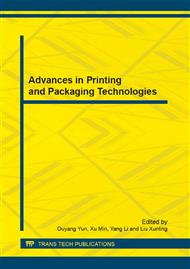p.497
p.501
p.505
p.510
p.514
p.518
p.523
p.527
p.532
Preparation of Cu NPs Suspension for Conductive Ink
Abstract:
Copper nanoparticles (Cu NPs) have attracted tremendous interest in recent years in the field of printable electronics due to their low cost and high conductive properties. In this study, copper nanoparticles were synthesized via a polyol method by reducing cupric nitrate trihydrate with hydrazine hydrate in the presence of PVP as protective agent. Collide of Cu NPs was obtained after three times of sedimentation by acetone. Suspension for conductive ink was then prepared by adding some amount of solutions and additives followed by parameters adjusting. Sheet resistance of the Cu NPs films coated on a glass substrate could be reduced to 750 mΩ/□ after heating at 300°C for 1h in vacuum.
Info:
Periodical:
Pages:
514-517
Citation:
Online since:
December 2012
Authors:
Keywords:
Price:
Сopyright:
© 2013 Trans Tech Publications Ltd. All Rights Reserved
Share:
Citation:


